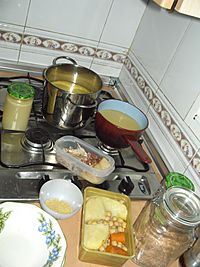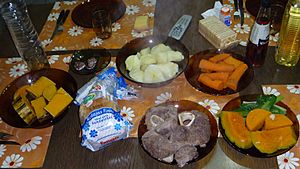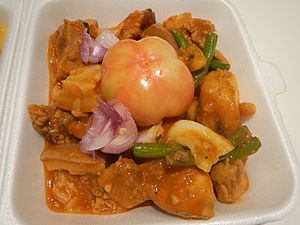Puchero facts for kids

|
|
| Course | Main course |
|---|---|
| Place of origin | Spain |
| Main ingredients | Varies by region |
Puchero is a warm and tasty type of stew that started in Spain. It's popular in many places around the world today, like Yucatán, Mexico, Argentina, Paraguay, Uruguay, Perú, southern Brazil, and the Philippines. In Spain, you'll find it especially in Andalusia and the Canary Islands. The word "puchero" originally meant an old-fashioned clay pot. Later, it came to mean any cooking pot, and then the delicious meal cooked inside it!
Puchero is quite similar to another Spanish stew called cocido. The main difference is that puchero usually doesn't have added colors like paprika. Instead, it uses fresh ingredients that are common in each local area. For example, in Spain, chickpeas are often a key part of the dish. Puchero is also like sancocho, a stew eaten in countries like Colombia, Ecuador, the Dominican Republic, Venezuela, and Puerto Rico.
Contents
Puchero in Andalusia, Spain
In Andalusia, a region in southern Spain, puchero was once a simple soup made by farmers. The main ingredients for its broth are different kinds of meat, like beef, veal, pork, or chicken. It also includes bacon, cured bones (like from jamón serrano), and lots of vegetables. These veggies can be potatoes, celery, chard, leeks, carrots, and turnips.
You can enjoy the broth on its own as a warm drink called caldo de puchero. Sometimes, people add fresh spearmint leaves or a splash of sherry wine to it. Or, you can make it a full soup by adding chickpeas, cured ham, boiled egg, and either rice, noodles, or bread. The cooked meats from the stew, known as pringá, are often served separately as a main dish. Any leftovers can be used to make other yummy meals, like croquettes or ropa vieja.
Puchero in South America

Puchero is a popular meal in parts of Argentina, Uruguay, and Paraguay, especially near the Río de la Plata river. It's made in a similar way to the Spanish version, but the ingredients are different because of what's grown locally. In these South American countries, puchero often uses a lot of beef, as beef was easy to find and cheap. Chickpeas are not as commonly used here as they are in Spain. People often eat the broth and the solid ingredients separately.
The type of meat used is very important for this dish. Often, people use ossobuco (a cut of veal with bone marrow). If that's not available, other beef cuts with marrow or even poultry (like in puchero de gallina which uses chicken) can be used. Other common ingredients include potatoes, onions, and squash. Local additions might be sweet potatoes, sweet corn, carrots, bacon, and a local type of chorizo sausage. You might also find pork belly, cabbage, and eggs in the stew.
Puchero is usually eaten during the colder months. It's seen as a comforting, home-style meal. You can find it on the menus of family restaurants throughout Argentina, but usually not in very fancy places.
Puchero in the Philippines

In the Philippines, puchero is called Pochero in Spanish and putsero in Tagalog. This version often features chunks of beef stewed with saba bananas (which are a type of plantain). The dish can also include potatoes or sweet potatoes, chorizos de Bilbao (a type of sausage), bok choy, leeks, chickpeas, cabbage, and tomato sauce. Sometimes, chicken or pork are used instead of beef.
Puchero in Yucatán, Mexico
The Yucatec puchero, found in Yucatán, Mexico, can be made differently depending on the cook and the area. The most complete version is called puchero de tres carnes, meaning "with three meats." This includes pork, beef, and chicken. Other ingredients might be a piece of plantain with its skin, onion, potatoes, sweet potatoes, carrots, squash (called calabaza), turnips or parsnips, and white cabbage (repollo).
Often, a type of pasta soup (like noodles or fideos) and rice are added to make the meal more filling, especially if only one or two meats are used. The soup part of Yucatec stews is usually thin and light, not thick or heavy. It gets its flavor from spices like saffron, allspice, and black pepper. The dish is served with all the ingredients in the bowl, along with fresh toppings on the side. These toppings usually include freshly chopped habanero chili, onion, radish, and cilantro. If they are in season, avocados are also a popular addition.
See also
 In Spanish: Puchero para niños
In Spanish: Puchero para niños

